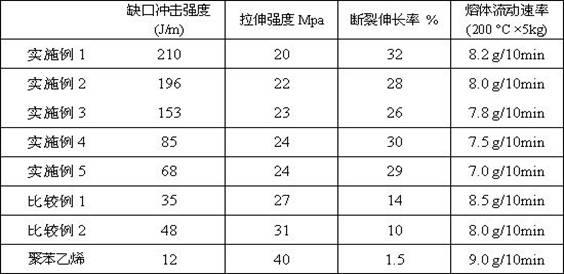Preparation method of ultrahigh-toughness polystyrene resin
A polystyrene resin and polystyrene technology, applied in the chemical industry, can solve problems such as weak interface ability and product performance impact, and achieve the effects of improved mechanical properties, large market competitiveness, and huge profits
- Summary
- Abstract
- Description
- Claims
- Application Information
AI Technical Summary
Problems solved by technology
Method used
Image
Examples
Embodiment 1
[0037] Polybutadiene rubber particles grafted polystyrene impact modifier was synthesized by graft polymerization technology at 65 °C. The styrene monomer is added drop by drop into the latex system of polybutadiene rubber particles by adopting the feeding method of continuous drop starvation method, and graft polymerization takes place. The feed ratio of polybutadiene to styrene was 70 / 30. The amount of initiator used is 1%, redox system, the oxidizing agent is cumene hydroperoxide (CHP), the reducing agent is ferrous sulfate (FeSO 4 ) and glucose (DX). Under the condition of nitrogen protection, the polymerization reaction continues to end after 4 hours, and the final conversion rate of the reaction reaches more than 90%. Add magnesium sulfate solution to demulsify, and dry to obtain polybutadiene rubber particle grafted polystyrene powder. As an impact modifier for polystyrene resin. A twin-screw extruder is used to blend and extrude high-impact polystyrene, polystyrene ...
Embodiment 2
[0039]Using the same method as in Example 1, the difference is that the feed ratio of the emulsion graft polymerization reaction has been adjusted, polybutadiene and styrene feed ratio are 60 / 40, and the polymerization temperature is 70 ° C. After 4 hours of reaction, The conversion rate reaches more than 90%. During the blending and extrusion process, the weight ratios of high-impact polystyrene, polystyrene and impact modifier graft powder were 30 parts, 46 parts and 24 parts respectively. The extrusion blending temperature was set at 200 °C, the mechanical speed was 70 r / min, and processed into pellets. After being dried in a vacuum oven, it can still be injection molded with an injection molding machine at 200 °C. A polymer resin is obtained.
Embodiment 3
[0041] Using the same method as in Example 1, the difference is that the feed ratio of the emulsion graft polymerization reaction has been adjusted, polybutadiene and styrene feed ratio are 50 / 50, and the polymerization temperature is 70 ° C. After 4 hours of reaction, The conversion rate reaches more than 90%. During the blending and extrusion process, the weight ratios of high-impact polystyrene, polystyrene and impact modifier graft powder were 30 parts, 42 parts and 28 parts respectively. The extrusion blending temperature was set at 200 °C, the mechanical speed was 70 r / min, and processed into pellets. After being dried in a vacuum oven, it can still be injection molded with an injection molding machine at 200 °C. A polymer resin is obtained.
PUM
 Login to View More
Login to View More Abstract
Description
Claims
Application Information
 Login to View More
Login to View More - R&D
- Intellectual Property
- Life Sciences
- Materials
- Tech Scout
- Unparalleled Data Quality
- Higher Quality Content
- 60% Fewer Hallucinations
Browse by: Latest US Patents, China's latest patents, Technical Efficacy Thesaurus, Application Domain, Technology Topic, Popular Technical Reports.
© 2025 PatSnap. All rights reserved.Legal|Privacy policy|Modern Slavery Act Transparency Statement|Sitemap|About US| Contact US: help@patsnap.com

